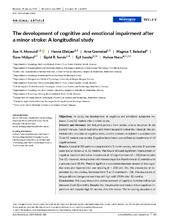| dc.contributor.author | Morsund, Åse Hagen | |
| dc.contributor.author | Ellekjær, Hanne | |
| dc.contributor.author | Gramstad, Arne | |
| dc.contributor.author | Reiestad, Magnus Tallaksen | |
| dc.contributor.author | Midgard, Rune | |
| dc.contributor.author | Sando, Sigrid Botne | |
| dc.contributor.author | Jonsbu, Egil | |
| dc.contributor.author | Næss, Halvor | |
| dc.date.accessioned | 2020-05-25T13:44:09Z | |
| dc.date.available | 2020-05-25T13:44:09Z | |
| dc.date.issued | 2019-09-04 | |
| dc.Published | Morsund Åh, Ellekjær H, Gramstad A, Reiestad MT, Midgard R, Sando SB, Jonsbu E, Næss H. The development of cognitive and emotional impairment after a minor stroke: A longitudinal study. Acta Neurologica Scandinavica. 2019;140(4):281-289 | eng |
| dc.identifier.issn | 0001-6314 | |
| dc.identifier.issn | 1600-0404 | |
| dc.identifier.uri | https://hdl.handle.net/1956/22371 | |
| dc.description.abstract | Objectives: To study the development of cognitive and emotional symptoms between 3 and 12 months after a minor stroke. Material and Methods: We included patients from stroke units at hospitals in the Central Norway Health Authority and from Haukeland University Hospital. We administered a selection of cognitive tests, and the patients completed a questionnaire 3 and 12 months post‐stroke. Cognitive impairment was defined as impairment of ≥2 cognitive tests. Results: A total of 324 patients completed the 3‐month testing, whereas 37 patients were lost to follow‐up at 12 months. The results showed significant improvement of cognitive function defined as impairment of ≥2 cognitive tests (P = .03) from months 3 to 12. However, most patients still showed cognitive impairment at 12 months with a prevalence of 35.4%. There is significant association between several of the cognitive tests and hypertension and smoking (P = .002 and .05). The prevalence of depression, but not anxiety, increased from 3 to 12 months (P = .04). The prevalence of fatigue did not change and was thus still high with 29.5% after 12 months. Conclusions: This study shows that an improvement of cognitive function still occurs between 3 and 12 months. Despite this, the prevalence of mostly minor cognitive impairment still remains high 12 months after the stroke. The increasing prevalence of depressive symptoms highlights the importance of being vigilant of depressive symptoms throughout the rehabilitation period. Furthermore, high prevalence of fatigue persisted. | en_US |
| dc.language.iso | eng | eng |
| dc.publisher | Wiley | eng |
| dc.rights | Attribution-NonCommercial CC BY-NC | eng |
| dc.rights.uri | http://creativecommons.org/licenses/by-nc/4.0/ | eng |
| dc.subject | cerebrovascular diseases | eng |
| dc.subject | depression | eng |
| dc.subject | mild cognitive impairement | eng |
| dc.subject | psychiatry | eng |
| dc.subject | quality of life | eng |
| dc.subject | strokes | eng |
| dc.title | The development of cognitive and emotional impairment after a minor stroke: A longitudinal study | eng |
| dc.type | Peer reviewed | |
| dc.type | Journal article | |
| dc.date.updated | 2019-12-13T13:42:13Z | |
| dc.description.version | publishedVersion | |
| dc.rights.holder | Copyright 2019 The Author(s) | eng |
| dc.identifier.doi | https://doi.org/10.1111/ane.13143 | |
| dc.identifier.cristin | 1736741 | |
| dc.source.journal | Acta Neurologica Scandinavica | |

